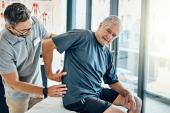Radiation Survey Reveals Variable Practices as Operators Look to Themselves for Fixes
Numerous opportunities exist for improving quality of care for patients and cath lab teams, says Andrew Einstein.

WASHINGTON, DC—A global survey of interventional cardiologists and staff hints that many could be doing more to protect themselves and patients from excessive radiation exposure in the cath lab.
The survey results, along with several other moderated abstracts presented here on the first day of TCT 2024, make it clear that radiation safety remains an ongoing process of education, self-awareness, and advocacy.
Aaysha Cader, MD (Kettering General Hospital, England), who presented the Women in Asian Pacific Society of Interventional Cardiology (WIN-APSIC) survey, said that the data offer a wide-ranging look at how staff see themselves, what they know about radiation, and what their institutions are doing to keep them safe.
“We asked them which radiation protection equipment they used regularly. The majority used lead aprons and thyroid collars, but only about 30% used lead glasses and only about two thirds used under-table [lead shields] and ceiling-suspended [transparent lead] glass shields,” Cader noted.
Fewer than 2% of respondents reported having access to more sophisticated equipment like robotic PCI and the zero-gravity Rampart (Rampart ic) portable radiation shielding system.
Cader and colleagues analyzed data from 304 respondents from 47 countries who took the anonymous 39-item online survey. Respondents included interventional cardiologists (n = 223), allied health professionals (n = 67) and electrophysiologists (n = 12).
The survey turned up some alarming data, particularly with regard to radiation badges.
“The majority, about 50%, wore one, but alarmingly, one fourth of the respondents did not wear a dosimeter, which is an opportunity for education and improvement,” Cader said.
Those who did wear a dosimeter were most likely to report wearing it at the waist/pocket (48.3%) or at the thyroid/vest pocket (31.5%).
Among the other survey findings were that:
- 20% said radiation protection training was not mandated for cath lab staff
- 27.6% did not have an assigned radiation protection officer
- 44% said radiation exposure was not recorded and reported for each case
- 36.7% were not informed about the radiation exposure data collected by their dosimeter; for those who were, the most common time frame was monthly
- 45.5% did not inform patients about risks of radiation exposure prior to procedures
The survey also asked about injuries and health conditions that cath lab staff had experienced that could be attributed to radiation exposure. Approximately 13% reported orthopedic injuries and 29% reported back pain/lumbar disk injury.
Surprisingly, 37% of respondents said they were unaware of whether radiation-related risks were considered an occupational hazard in their country and about 36% said there were laws in their country to prevent women who were pregnant from working in the cath lab.
“We've identified very key areas that we can work on, and it could start off with just the delivery of education . . . and go on to bigger things like actually influencing policy,” Cader said. She added that consensus documents and webinars might be next steps in raising awareness.
Roughly one-third of respondents said they used an exercise routine for core strengthening and reducing their risk of orthopedic injuries.
Andrew Einstein, MD (NewYork-Presbyterian/Columbia University Irving Medical Center, New York, NY), who co-moderated the session, told TCTMD that the survey is likely eye-opening for the many operators who don’t realize how much variability exists in radiation practices and awareness depending on where in the world people practice.
“Data like this identifies numerous opportunities for improving the quality of care we provide both for patients and for our teams,” he said. “It’s a step in the right direction. Maybe we can envision a future where there's a procedural theater, as it were, that is shielded and where the patient is inside receiving the radiation while the staff are uniformly protected.”
Adjustments Based on Real-Time Data
Taking personal responsibility for radiation-related health effects was a theme echoed in a separate presentation by Christine Shen, MD (Scripps Clinic, La Jolla, CA), whose motive was to understand what she could do to reduce her radiation exposure as a primary operator using a portable radiation shield and real-time dosimetry monitoring.
She reviewed sequential coronary cases (60% PCI) from her institution that were done between January and April of this year. Operators wore the dosimeter on their left shoulder and used the real-time information to adjust their positioning and/or shielding.
“The study allowed me to explore behavioral modifications as I became more acquainted with the impact of my body position on my radiation dose,” Shen said. “For example, when I lean against the table, the dosimeter light often turns on during cine, so I know I am still getting radiation. But when I stand back, the light was often no longer there during cine acquisition.”
Her three most important takeaways: step back, adjust shielding, and use additional radiation pads between herself and the patient.
“By keeping the pads in the sterile packaging, they were reused for multiple cases and did not add further expense to the case,” she added.
By making adjustments based on the real-time information, Shen said overall procedural radiation and fluoroscopy times did not decrease, but primary operator radiation exposure did. The study helped her understand how to better protect herself, and she believes other interventional cardiologists can and should do the same. The more operators take the lead on protection, she added, the more likely it is to become the norm and set a positive influence.
Einstein and others in the session pointed out that the cost of equipment, such as the portable shields used in Shen’s study and reported to be available to very few in Cader’s survey, is a significant consideration for hospital systems, which is why data on how they are being used to improve safety are especially important.
According to discussant Robert Foster, MD (Birmingham Heart Clinic, AL), who helped design the Rampart shield so he could continue working in the cath lab after undergoing two back surgeries and experiencing temporary paralysis of his leg, the system costs about $185,000.
“Real-world studies are important to continue to build on the data and to support regulations,” he said. “Whether its Rampart or [something else], we need to find a solution that gets you out of lead if you can. Whole room protection is what we’re striving for. We need everyone protected at the highest level they can be.”
L.A. McKeown is a Senior Medical Journalist for TCTMD, the Section Editor of CV Team Forum, and Senior Medical…
Read Full BioSources
Cader FA. Radiation hazards and safety among physicians and allied health practitioners in invasive cardiology procedures. Presented at: TCT 2024. October 27, 2024. Washington, DC.
Shen C. Reduction of primary operator radiation dose with portable radiation shielding and real-time dosimetry monitoring. Presented at: TCT 2024. October 27, 2024. Washington, DC.
Disclosures
- Cader and Shen report no relevant conflicts of interest.





Comments